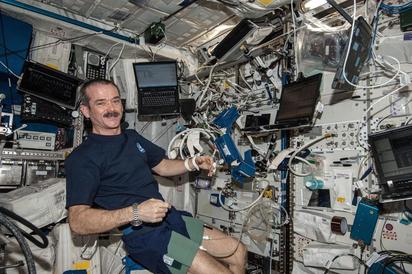Dr. Kushal MadanCardiac Rehabilitation Consultant, Dept. of Cardiology, Sir Ganga Ram Hospital New Delhi India  Here on Earth our arterial blood pressure values are set by the pumping action of our heart and by the resistance of our arteries to blood flow, known as peripheral resistance. Haemodynamics, or the flow of blood in our circulatory system can be summarised as:
The question is though, what happens to blood pressure in Space? How does the microgravity environment that the human body experiences in the ‘weightlessness’ of space affect it? Weightlessness during spaceflight immediately leads to a shift of blood and body fluids from the lower to the upper part of the body. As the central blood volume increases, there is an increase in cardiac output. But the head-to-foot blood pressure gradient that exists on Earth is removed, thereby dilating the arterial resistance vessels and reducing systemic vascular resistance. In the space environment, simultaneous to the increased cardiac output, arterial blood pressure either remains the same or is slightly decreased. So, what is the reason for the systemic vasodilatation leading to a reduction in blood pressure in space? Are these changes short-term or do they persist throughout the spaceflight? In 1996 Fritsch-Yelle et al. concluded that there was a decrease of 5 mmHg in diastolic blood pressure and no change in systolic blood pressure, as measured by ambulatory brachial blood pressure monitoring using a portable equipment over the 2 weeks of a spaceflight.  Expedition 35 Commander Chris Hadfield taking part in blood pressure regulation experiment (2013). Image courtesy of NASA Expedition 35 Commander Chris Hadfield taking part in blood pressure regulation experiment (2013). Image courtesy of NASA Ambulatory blood pressure monitoring (ABPM) is a continuous blood pressure recording over a 24-hr period to assess the pattern of variability in arterial blood pressure during rest and exercise. ABPM can detect circadian changes, such as nocturnal dipping and morning surge. According to the American College of Cardiology/American Heart Association 2017 guidelines, a normotensive patient should have a daytime ABPM <120/80 mm Hg, and a night time ABPM < 100/65 mm Hg. This technique can also pick up on the variations in arterial blood pressure due to different environmental and emotional changes, and it can overcome the disadvantages of manual arterial blood pressure recording, such as white coat hypertension. The use of this technique in aerospace applications has provided valuable information regarding the mechanisms of blood pressure regulation. Another important use of this method of arterial blood pressure monitoring is in assessing the effectiveness of countermeasures applied to reduce the adverse effect of weightlessness on the cardiovascular system. Initial studies conducted on astronauts have shown that ambulatory blood pressure equipment can detect the increase and decrease of blood pressure before, during and after spaceflight. Therefore, it would seem that these ABPM devices have a very useful role to play in detecting the blood pressure changes that occur during the stressful and hostile situations found during space missions. Comments are closed.
|
Welcometo the InnovaSpace Knowledge Station Categories
All
|
InnovaSpace Ltd - Registered in England & Wales - No. 11323249
UK Office: 88 Tideslea Path, London, SE280LZ
Privacy Policy I Terms & Conditions
© 2024 InnovaSpace, All Rights Reserved
UK Office: 88 Tideslea Path, London, SE280LZ
Privacy Policy I Terms & Conditions
© 2024 InnovaSpace, All Rights Reserved
 RSS Feed
RSS Feed